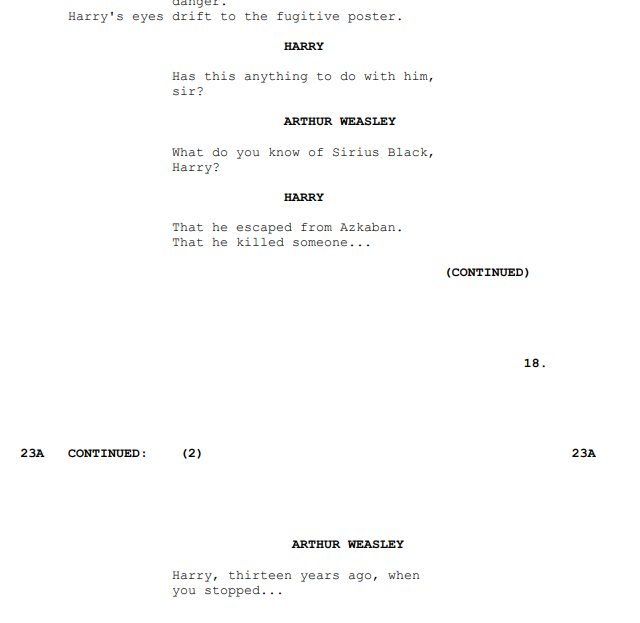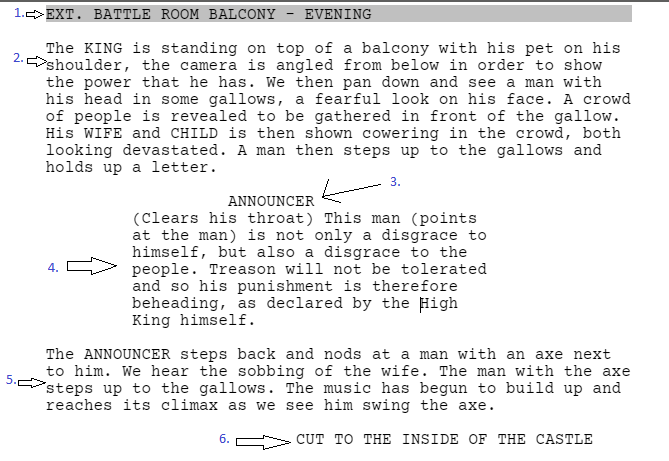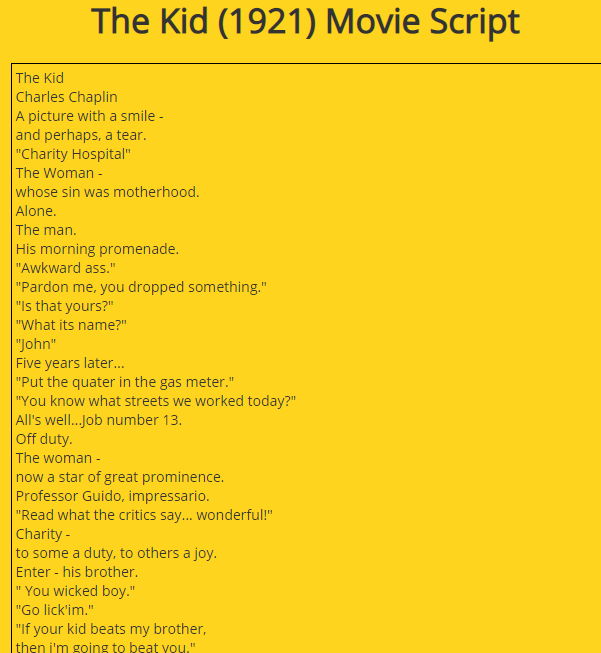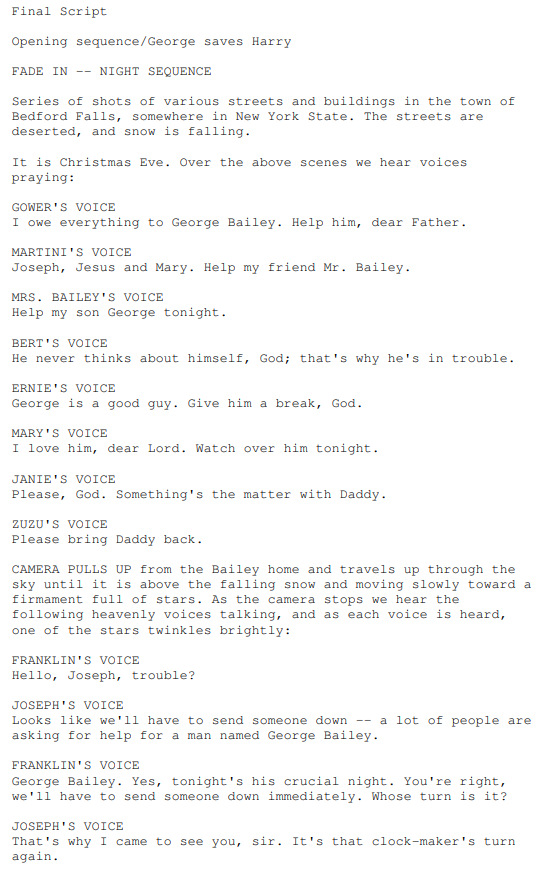In order to write my script I needed to find a programme which could cater to all my needs and make it as easy as possible to write a script without all the hassle. I figured out that the perfect choice for this was to use Celtx, not only because I have some prior experience with using it (in Unit 1 in particular), but also because it is easy to use. This is because you are able to change the setup of each line very easily, whether it be the dialogue or parenthetical.
As well as this I am going to use this section in order to work out how to write a script, including character development and engaging dialogue.
Tracking Shot
In the second scene in the script I want it to be a Tracking Shot as we follow a Townsman through the village, and see the carnage that has been caused by the way the King rules and the Totalitarian society that he has created. In order to do this I needed to do some research into what ways the industry write tracking shots, and which one would be most useful to me. One tracking shot in that stands out to me is the scene in the Leaky Cauldron in Harry Potter and the Prisoner Of Azkaban (the scene is linked below):
In this scene the director, Alfonso Cuaron, brilliantly establishes the magical world created in Harry Potter. He does this through lots of detail and small things going on which remind us throughout that this is not a normal world. Things including the dish washing itself and the background music help to create an atmosphere of somewhere slightly magical, whilst also helping us as the audience to feel like we’re a part of the magical universe. This is something that I want to portray in my script, and to help establish the awful way in which the Towns people are treated in order to build up sympathy for them, and portray the King in a bad way.
When it comes to actually writing the script I wanted to get some techniques before I delved into it, and so I took some screenshots of the script in the scene above:



The above script is slightly different to the finished product seen in the film. I believe that this might be because the writer didn’t envisage the scene as one that would be taken in one shot, and instead this was a decision decided by the director whilst filming. Bits may also have been improvised by the actors to make it look more realistic, although I am slightly disappointed to see how little detail from the scene is mentioned in the script. In order to rectify this and make sure that I don’t do the same in my script I am going to begin by mentioning that the scene is a tracking shot, and then go through what he walks past in the action part of the script. I will go into much more detail than this script and make sure that all of the key details, that I would want if I was to shoot this scene, are mentioned. The scene is the third one in my script, and I want the focus to be on the main character whilst all of the background stuff is there to set up the society that these people live in. I then ant this to contrast to the hope that is in the rebel base. Therefore the rebel base will be much brighter whilst the town will look dull and hopeless. I will then make it clear for where the tracking shot ends by writing end of tracking shot in the the shot section on Celtx.
Details in script
Many scripts include little snippets of detail in order to help the director and set-crew work out how they want the scene to roughly look. As my script is solely that, and is purely going to be read, I am going to include a little bit more detail into what I want to be going on in the background. This will help the people reading it to envisage what I want from each scene.
Layout of a script

- The top line of the script is called the Scene Heading and is where the location that the scene will take place is written.
- The next paragraph is called the Action, and it’s purpose is the same as it’s name. It describes the action taking place in the scene.
- This third type of text is called Character, and is where the characters name who’s speaking is written.
- This chunk of text is called the Dialogue, and is what the character is saying.
- This next bit is just simply called Text, and is where you can write either the action or the cinematography that you want to happen in that scene.
- This final piece of text at the bottom is called the Transition, and is where you write down how this shot will flow into the shot in the script.
History of scripts
The very first scripts ever written were very different when compared to the detail that goes into them today. In the 1921 film The Kid by Charlie Chaplin, the script is as simplistic as they come. The basic layout of the script is below:

A lot of the scenes are written with single sentences, such as ‘His morning promenade’. This may have been because Charlie Chaplin knew had all the ideas in his head, but also because back then in the 1920’s it was more about the film itself and it was unusual for them to have many complex scenes due to the lack of technology. As it was also a silent film there would have been a lot less dialogue and so you can understand the lack of information given for those. As it is though, I feel that as there is such little information given here that means that this is a very weak and lazy way to write a script. It is also quite hard to follow what is going on as there is so little detail in the scene, and even though this worked for Charlie Chaplin as he knew what was going to happen, my project is just a script and so I am going to need to go into a lot more detail than he did here.
As time developed, so did the scripts used in making films. Technology grew throughout the next few decades in film-making, and suddenly there were a lot more options for screenwriters to use and mention in their scripts. This was when the golden years of Hollywood started and so I decided to look at a script from this time period. A film that is a favourite of my dads’ is It’s A Wonderful Life (1946), written by a host of writers who were commissioned by Frank Capra. The idea for the film was originally taken by a short story Capra saw on a Christmas card he received. I decided to take a look at this script therefore to see how much development had been made since the 1920’s;

The format of the script was much more like it is nowadays, with more information mentioned about what the screenwriter/director wanted from each scene, and the characters name now being mentioned above their dialogue. The detail mentioned, although now increased from the 1920’s, was still very little. Nothing is mentioned as to what the characters are thinking or feeling and although the camera movement is mentioned, it is minimal. I feel that again this is lazy writing, but may have been done as the director already had in mind what he wanted, especially as he had multiple scripts he was working from at once. However, this does mean that as a reader of the script I have no idea how the film opens. As I don’t want to fall into these same pitfalls, I am going to use this knowledge to make sure that I go into more detail in my own scenes to make sure that whoever marks my work understands fully what I want to happen in each scene.
Films then continued to develop as we left the golden age of film and began to enter the world of the Blockbuster. One of the earliest examples of these kind of films was Jaws, directed by Steven Spielberg. The first few pages of the script are shown below;
Before I started doing any research this is how I envisaged most scripts being. As you can see this script is a lot more developed and descriptive than either The Kid or It’s a Wonderful Life. That is because it goes into detail about it wants from each individual scene or shot. This leaves the director and people reading it no doubt about what happens. Although this gets rid of the freedom that the filmmakers had in the earlier scripts, I still feel it is better as not only does it mean that as readers we know exactly what is going on, but it is also much easier to follow. This is because with each scene it explicitly states where the actors are going to be and what they are saying. However, if I was going to criticise it, I would say that it is written possibly too much like a story and doesn’t really convey how it wants it characters to act and talk like. These are things that I am going to try and improve on as I write my script. Despite this though, I would like to match the amount of detail gone into the Jaws script, especially as mine is just a script and so the readers will have nothing else to go off. I therefore feel like script-writing has come a long way, but has definitely improved despite not being as simplistic as it used to be.
Formatting scripts
In order to keep my script as easy to read as possible I am going to try to keep the layout as simple and unsophisticated as possible. This means that I want it to be clear about which parts are set directions, dialogue etc. However, as my project is just the script, I also want my vision to be clear to the reader and so I am going to go into more detail into the action going on in my scenes than most scripts tend to do. The programme most-suited to this kind of script-writing is Celtx, and as I have previous knowledge from using this (look at Units 1 and 6 for proof), it is clear to me that this is my best bet. When looking at other scripts, some tend to over-simplify things and sometimes it isn’t enough to gauge what the writer wants from each scene. An example of this is The Kid script which I have already mentioned. Therefore I am going to use as many of the different functions as possible in order to indicate where I would want a shot to change, what I want the characters reactions to be and how they say things as well. This is the way I feel is best in order to represent the characters personalities, and also is a way to have some hidden messages in my film that usually doesn’t get mentioned in actual film scripts.
Writing Dialogue
In order to help me to improve my writing abilities, specifically when it comes to dialogue, I watched this YouTube video:
This video is by ‘The Closer Look‘ who make videos about screenwriting. This video it explains, as the title says, how to write great dialogue. The key points from this video are:
- A lot of the best dialogue is when 2 opposing forces are clashing.
- The dialogue should aim to carry the story forward.
- Try and have a hidden message in the dialogue.
- Subtext is the most important part of the dialogue, they need good meaning behind what they say. Otherwise it’s just empty words and you don’t want to be too on the nose with what you say.
I agree with the majority of what this video is saying, as subtext is very important when writing dialogue. You also want to make the reader think about what is being said and so don’t want to spoon-feed them the information. For instance, if a character is feeling sad instead of them saying ‘I am sad’, it would be much better to have them say ‘I’m fine’ but in a trembling voice. This conveys the sadness but also means that the audience engages with them more as they realise that the character is sad instead of just straight up being told that the character is sad. In terms of the dialogue has to carry the story forward, whilst I think this is necessary some of the time, it is also important for character development too. What I mean by this is that the story can stay in the same place, as long as something else is being developed by the dialogue as otherwise the script just stands still and the pace of the story is too slow and off-balance. I do disagree with the first point however, as whilst I feel that dialogue is usually really good when 2 forces are clashing, it’s not the only time that dialogue is well-written. It is however the most crucial part of the story and so the dialogue needs to be good in order for the viewer to feel satisfied after watching it. Overall therefore, I found this video very useful when it comes to writing dialogue. However, I don’t feel it covered everything and so I am going to watch another video to help me get an even clearer idea of what makes good dialogue.
Another YouTube video that I thought would be useful in helping me to improve my writing abilities is the one linked below:
Having watched this video the key points that I have gathered are:
- Talking added to more realism and character development after being introduced in the mainstream in 1928 to replace the silent films.
- Exposition dialogue should give as much information as possible, but in a swift manner so it doesn’t become too boring. Voice-overs are often lazy ways of doing this as you are spoon-fed the information instead of having to work it out through the conversations being had.
- You should try not to say information too plainly, and instead should reveal it through what’s being said instead of straight up saying it. E.G. Billy Elliot did this better than Big Hero 6. In this Billy Elliot gives us enough information to work it out, but doesn’t straight up say it which Big Hero 6 does.
- Themes should be hidden in the dialogue but not straight up said. Instead should be suggested but not straight up mentioned.
- Sometimes dialogue seems pointless but sets up major plot points and conflict.
- Make sure that all dialogue has a purpose in your story, even if it’s not that clear.
- Character flaws can be shown through dialogue, such as that which Tarantino uses in Reservoir Dogs.
- Make sure to use a mixture of dialogue and visuals to show your story.
Having watched 2 videos on how to write dialogue, I feel I have a solid foundation to build upon. When it comes to the differences between the two videos, I feel that the second video better explains how dialogue should be used. That is because it says that ‘all dialogue should have a purpose in your story, even if it’s not clear’. In the other video it says ‘the dialogue should aim to carry the story forward’ which suggests that it should be more story-based, and so there would be less character development. Saying all dialogue needs a purpose is much clearer and although it’s more vague it gives the writer more freedom as they write their story. It also means that you can develop things other than the story-line, such as the themes of the story. When it comes to the exposition points in the video I also agree with these and I am going to aim to give information through mediums such as conversations between the characters and not by straight up saying what they’re feeling etc.
In conclusion therefore the way that I am going to use this in my own work is by making sure to reveal information slowly through dialogue, reveal the characters emotions but never straight up state them, and to make sure that the dialogue in my script always has a good purpose.
Writing a Plot Twist
This video was made by the YouTube channel Now You See It, who are well known for their videos on how films and scripts are made, and for making tips and tricks videos. I decided that they would therefore be a very good source of information for finding out how to write a plot twist, especially as there is one in my story when it comes to the King revealing that he is not evil.
In the video it set out two rules that every screenwriter must follow in order to write a good plot twist. These were:
- Shock value of the twist- audience not knowing it’s coming.
- The audience having enough information to be able to tell what the plot twist is.
What the video sets out as a good plot twist is one in which there is enough information given throughout the story for the audience to be able to tell what the plot twist is, but not enough for it to be too obvious that the plot twist is coming. I feel that these are very good guidelines for a good plot twist as not only does it create a kind of build up to the twist that the audience can then follow, but it also wouldn’t put the audience into the know-how that a plot twist is actually coming. If done like this too, second-time viewers won’t get tired of the twist either as they can watch it back and look for the clues as to what is coming, which can be just as enjoyable to watch. In order to ensure that I do this in my own script I am going to
Writing Endings
Having watched this video, the useful information I gathered which I am going to use when it comes to writing my ending are:
- A good ending entails one that satisfies the reader and has room for a sequel.
- The ending should be left on a cliffhanger.
- The shorter the amount of time between the climax and the end the better.
- End with a final not of uncertainty (such as a question)
- The closer the plots are resolved to one another the better, catharsis (providing relief from, strong or repressed emotions) is the weapon of the climax. I.E. the Lord of the Rings ending where Boromir gets his character resolution. Doesn’t need to be plot-based if a good character arc is complete.
- Try and weave a character arc into the main story and have it complete at the end to create audience satisfaction.
From watching this video I feel that my ending only does half of this. Therefore although to an extent I have led to a possible sequel, I don’t feel that it was explained enough for the audience to get excited about it. I do however feel that having a good character arc is essential for the ending to feel satisfactory and so I am going to use the character of the King to satisfy this.
In Conclusion
In conclusion, from all of this research I have learnt not only how to structure a script and format it, but also how character arcs, plot twists, dialogue and writing endings works. The way scripts have developed over time is also useful to me as it helps me to develop my own knowledge of how the industry has changed but also gives me different techniques for which I can use to write my own script. Therefore, I feel that this was all very beneficial research.